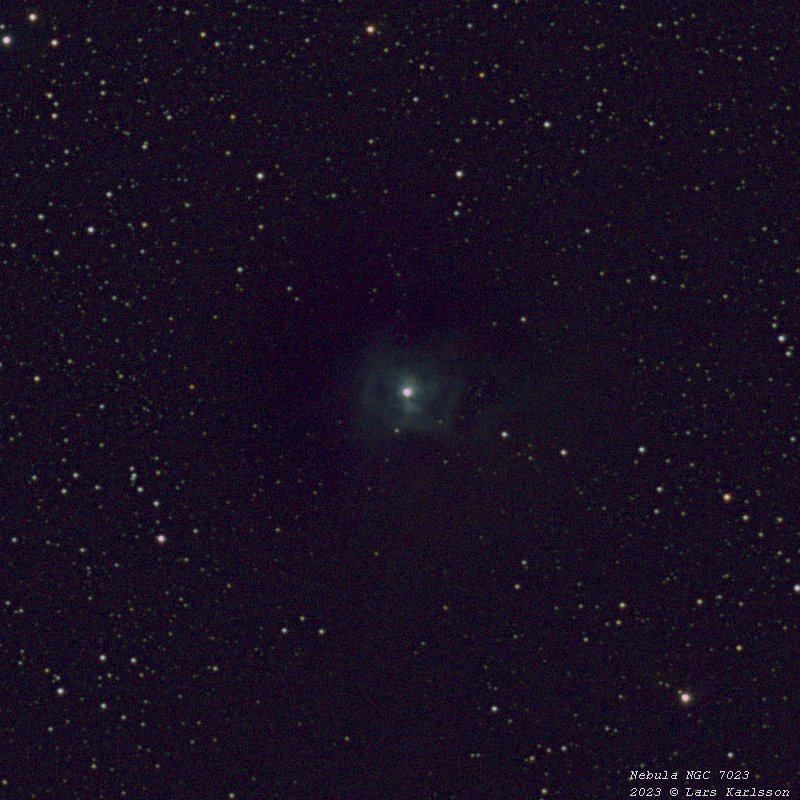|
Advertisement / Annons: |
Nebula |
| Object : | NGC 7023, Iris Nebula |
| Coordinates/Direction : | RA: 21h01m, DEC: +68o10' |
| Object size : | 18'x18' |
| Object magnitude : | 6.8 |
| More to know : |
Wikipedia: https://en.wikipedia.org/ wiki/ Iris Nebula |
NGC 7023 Nebula 2023-04-01 and 2023-04-10 (Click on image and get a full resolution image in a new window)
(Click on image and get a full resolution image in a new window)
|
| Date : | 2023-04-01 and 2023-04-10 |
| Time (UT) : | - |
| Mount : | SkyWatcher HEQ5, belt modified, low rider |
| Guide : | QHY5 camera with 200 mm f/3.5 lens |
| Lens/telescope : | Pentax 645 300 mm ED f/4 (medium format lens) |
| Corrector/Barlow : | - |
| Field (FOV) : | 6.8x4.5o (full frame) before crop |
| camera : | Canon 6D, QE=0.5, full frame, 20 Mpixel, 14 bit |
| camera temperature: | About 6o C above surrounding temperature |
| Film/CCD : | Raw, Cr2 |
| Filter : | none |
| Control system: | Mount, camera, focus, guide (Ekos) controlled by Astroberry (KStars/Ekos Linux) |
| Exp. time : | 30x30 seconds and 120x60 seconds, iso1600, dithering mode |
| Image process tool : | Siril, Gimp, Irfanview |
| Processing : | Calibrated dark, flat and color |
| Weather : | clear |
| Site : | Sweden, Stockholm, Hagsätra.
Bortle 9 Free view Az: 20o to 90o, 165o to 185o, Alt: 20o to 55o |
| Comment : |
When the season come close to the end it's in hurry to find more objects to take photographs of.
This is the NGC 7023 nebula, even called Iris Nebula.
It's a bright reflection nebula.
The angle size of it is almost as the Moon, but still with a 300 mm lens it will be small.
See the bright dot in center. Even when I collect exposures from two different nights as I have done here the nebula is weak. A total exposure of 135 minutes. The biggest problem when photographing nebulas is that you must have a dark sky or narrow band filters. That wasn't the case this time. Note how the surrounding of the nebula doesn't have many stars. The nebula is much bigger than the bright part, the empty area are where the nebula block the stars behind. |
NGC 7023 Iris Nebula 2024-03-06 (Click on image and get a full resolution image in a new window)
(Click on image and get a full resolution image in a new window)
|
| Date : | 2024-03-06 |
| Time (UT) : | 23:10 - 00:09 |
| Mount : | SkyWatcher HEQ5, belt modified, low rider |
| Guide : | QHY5 camera with 200 mm f/3.5 lens |
| Lens/telescope : | Pentax 645 300 mm ED f/4 (medium format lens) |
| Corrector/Barlow : | - |
| Field (FOV) : | 6.8x4.5o (full frame) before crop |
| camera : | Canon 6D, QE=0.5, full frame, 20 Mpixel, 14 bit |
| camera temperature: | About 6o C above surrounding temperature |
| Film/CCD : | Raw, Cr2 |
| Filter : | none |
| Control system: | Mount, camera, focus, guide (Ekos) controlled by Astroberry (KStars/Ekos Linux) |
| Exp. time : | 60x60 seconds = 60 minutes, iso1600, dithering mode |
| Image process tool : | Siril, Gimp, Irfanview |
| Processing : | Calibrated bias, flat and astrometric color |
| Weather : | clear, temperature +3o C |
| Site : | Sweden, Stockholm, Hagsätra.
Bortle 9 Free view Az: 20o to 90o, 165o to 185o, Alt: 20o to 55o |
| Comment : | The Iris Nebula is not far from us, only 1300 light years. |
|
| Go Back |